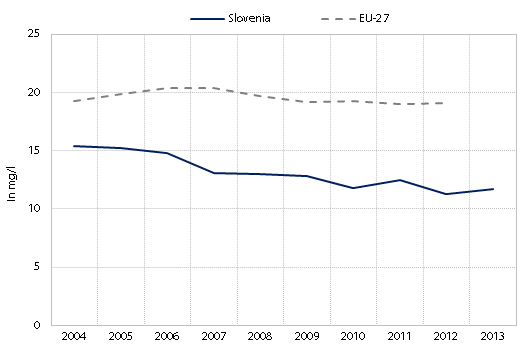ENVIRONMENTAL WELL-BEING - Water
The indicator Nitrates in groundwater shows average annual concentrations of nitrates in groundwater samples. Groundwater in Slovenia is the main source of drinking water and nitrates in higher concentrations are harmful for human health. Growth of the indicator has a negative impact on well-being.
Figure: Nitrates in groundwater, Slovenia and the EU, 2004−2013 (mg/l)

Source of data: Slovenian Environment Agency, European Environment Agency.
Note: Nitrate natural background depends on the geological structure of aquifers and is in Slovenia below 10 mg NO 3/l.
In 2013, the average concentration of nitrates in groundwater in Slovenia slightly increased over the 2012 value, but it was still more than a quarter lower than in 2004. Nitrate pollution of groundwater is the greatest problem in the north-eastern part of Slovenia, but trends are favourable. Increased concentration of nitrates in groundwater is the result of human activities, particularly agriculture, but also of unregulated discharge of municipal wastewater.
Results of supplementary indicators show:
The quality of drinking water, measured as a share of non-compliant samples, shows that the share of non-compliant samples due to faecal pollution continued to fall in 2013 (from 6.7% in 2012 to 4.3% in 2013; in 2004 it was 19%). With annual variations, in 2013 a significant improvement as regards pollution with chemicals (nitrates, pesticides, arsenic) was detected, i.e. from 3.6% to 1.9% of non-compliant samples in 2013 (in 2004: 5.6%).
In 2013, 79.6 m3 of water was abstracted per person in Slovenia for public water supply, economic and non-economic activities, which is slightly less than a year earlier and 11% less than in 2002.
The total renewable volume of groundwater in shallow aquifers in Slovenia was in 2013 well above the long-term average; significant annual variation point to the sensibility of this source.
The share of surface watercourses with bad or very bad ecological status in Slovenia (6%) is lower than in the EU overall (15%), while the share of underground watercourses with bad or very bad chemical status in 2008 in Slovenia (19%) was higher than in the EU overall (15%), but it decreased to 14% in 2013.
In 2013, 54.9% of people in Slovenia were connected to wastewater treatment plants with at least secondary treatment; the share is increasing.
